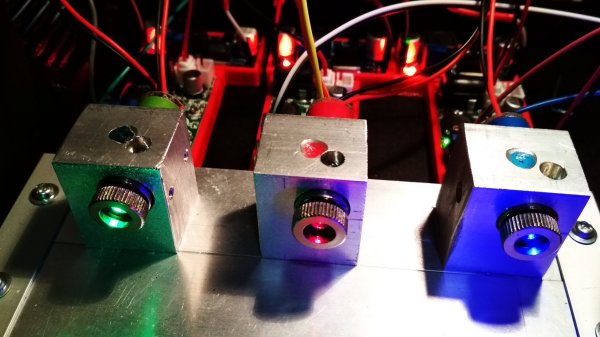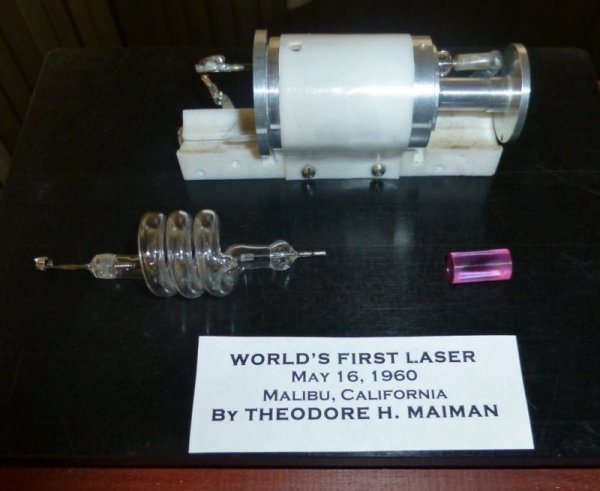Lasers came into my hands initially as a direct contamination of my passion for Astronomy, first they were used as pointers, a convenient aid for certain operations, such as pointing to celestial objects, satellites. They proved to be a practical convenience to indicate instead of quickly uttering a sequence difficult to interpret by some, of "up/down/there/near/above" with a nice "look here" .
Also because as far as I could tell the words do not have the same meaning for all people, and even left right still presents unknowns for some.
The laser is certainly more immediate; to look is capable of almost everyone.

My first self-made RGB laser.
So these pages serve to share (as per my old habit), my hobby, which has replaced part of the evenings outdoors trying to frame objects that have now become invisible, thanks to the complete erasure of our sky. Between terrestrial lighting, airport lights and private lights (to illuminate munchkins and swimming pools), added spy and geographic satellites (+ the Iridium flares that occasionally pop up in the sky), and which have virtually hidden all or most of this natural beauty, without moving a few hundred miles, there is very little to see.
Younger kids today have no memory of when lost, having been born and lived under a virtually continuous blanket of light that can hide 99 percent of the sky, they have no idea what has been stolen from them either.
The sky has been replaced with photos of pictures from the company "Piero Angela" , which show altered photos to gather consensus, which is common for the media and regulators.
For this reason, if you take a little boy to a really dark place where he can see the real sky, take care to prepare him so that he will not dislocate his jaw from the wonder of being able to see a starry sky on a clear evening, without the cloak of light pollution in the province of Varese (and Lombardy not to say Italy). You will also have to explain to him why there is no sign at the telescope of the pictures he sees on television.
So I have gone over to the other side, and I too can participate in the useless orgy of light that hides our beautiful sky from the eyes now of 99% of the population, with a few of my feeble beams pointed skyward (well given the logical necessities of not making disasters, it is something that happens now very rarely and under safe conditions just for a few tests).
Now I build put together, either one object or another, but by and large lasers, and aiming now toward self-built devices of some quality that can be used for holography.
I've given up building things like laser flashlights, which in the wrong hands do more damage than anything else, and don't allow for any progress.
So since I can have no certainty of what will be done with these objects I have decided NOT to sell them, and although I could do mass production, I leave it to the Chinese with less scruples than me to continue to provide these dangerous and useless objects in the hands of people unfit for the progress of the human species.
A bit of history...
Laser technology is relatively young.
The first laser was built in 1960 by Maiman at AT&T Labs in the United States. It was a ruby laser in the shape of a cylinder; this shape was chosen because of its predisposition for symmetry of the emitted beam and its easy manipulation with optics added after the emitter.
From this device, solid-state laser technology was rapidly developed. the main geometrical shape used for the active element remained the cylinder.
But many other solid-state materials were tested. The most widely used solid-state laser has been the YAG laser, which because of its versatility has assumed a very important role in almost all areas of application, namely, medicine, industry, and research.
Lasers built in a plate, as well as rod lasers in array form, have also been tested from the beginning. These are mainly built in a cubic or flattened plate form that contains emitters.
However, these lasers have not become very popular within the industrial sector because of their pronounced tendency toward beam astigmatism, which must inevitably be corrected with more or less expensive optics.
Later developments in the geometric shape of the laser are, for example, fiber lasers. In these lasers, the laser medium is again cylindrical, but with extreme diameter-to-length ratios. Both have excellent power scalability and can achieve high power in continuous wave (CW) mode.
Thus, the cylindrical bar laser was the first laser built and for some characteristics the best.
If we judge the worldwide annual sales total, cylindrical rod lasers are still the strongest group of solid-state lasers because of their wide applicability.
One feature of the bar laser is the cylindrical shape shape of the active laser medium, given the symmetry of the cylinder, the light from the pumping system can also be coupled with the cylindrical symmetry of the active element accurately, which improves the beam characteristic.
Below is what the first laser built, a simple ruby ROD, looked like with its pumping lamp and optical cavity to maximize its emission.
The appeal of the ruby laser remains unchanged.

Image under Creative commons rights
To date I am also working on building a ruby laser as well, it will take a lot of effort, but it is fascinating to be able to rebuild such an object, and even though it will take a long time it is always worth it.
Francesco
|

